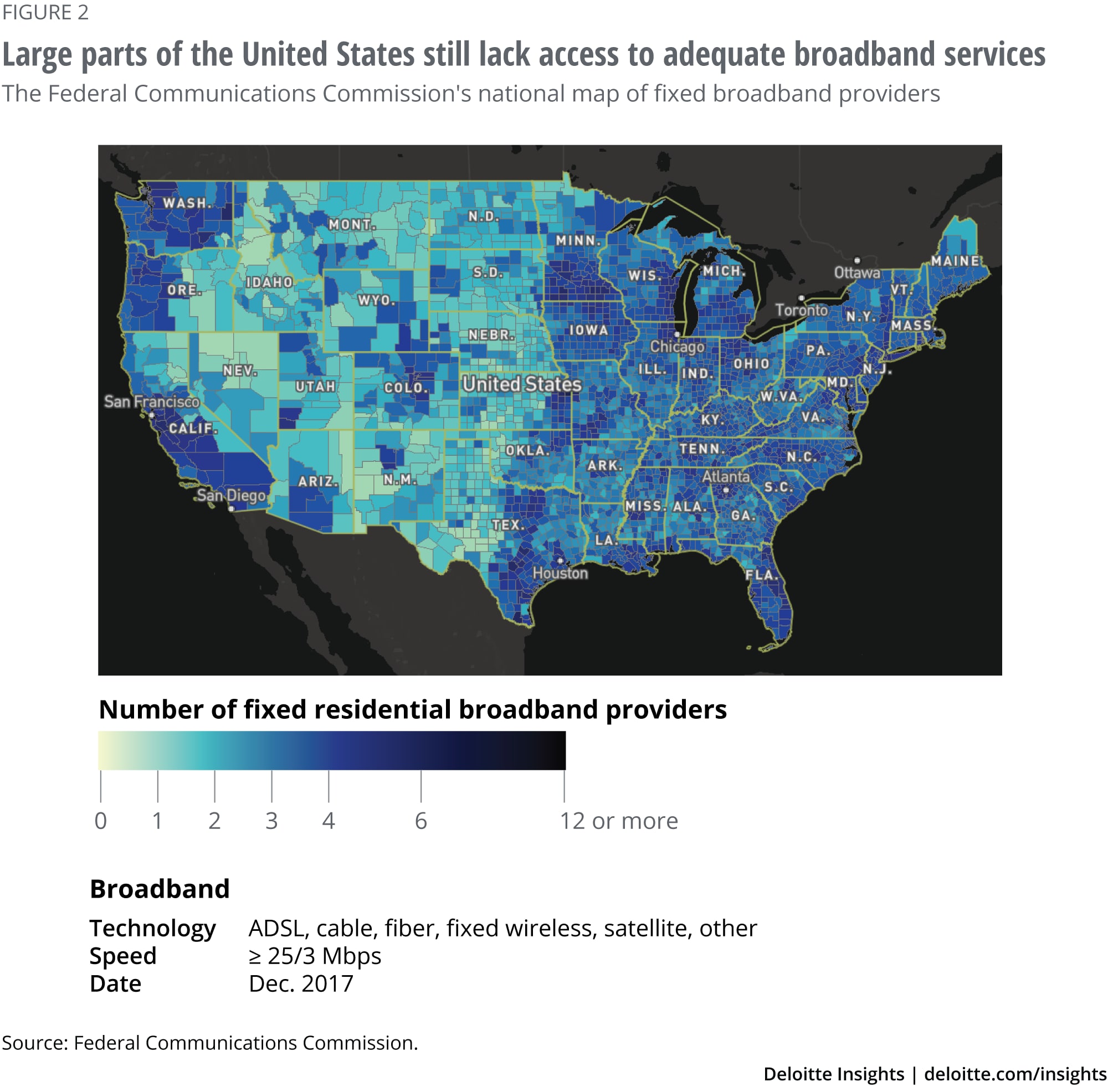
The promise of smart rural communities Unlocking new economic value
15 minute read
27 September 2019
Can the promise of smart cities be extended to rural areas as well? Improving connectivity in these areas is a necessary first step to unlocking new economic value.
Not your grandfather’s farming
Take a trip to West Lafayette, Indiana, and you’ll get a glimpse into the future of farming in America. Situated at the intersection of the Great Prairie and a vast stretch of hardwood forest, the Agronomy Center for Research and Education (ACRE) at Purdue University comprises 1,400 acres of farmland undergirded by long-range Wi-Fi and an extensive network of sensors that enable the daily collection of 1.4 petabytes of data. ACRE represents the epicenter of the “Agriculture 4.0” movement, an effort to harness technology—from drones and satellite imagery to global positioning systems (GPS) and a wide array of Internet of Things sensors—to significantly increase the productivity of farming. By collecting, analyzing, modeling, and visualizing huge quantities of data, researchers at ACRE can better understand the impact of various inputs—water, fertilizer, and soil types, among others—and tailor farm operations with more precision. The goal? To reduce costs, improve yields, increase efficiency, and enhance the nutritional value of crops, in order to feed an estimated 9 billion people by 2050.1
Learn more
Read more from the Smart cities collection
Explore the Government and public services collection
Subscribe to receive related content from Deloitte Insights
Download the Deloitte Insights and Dow Jones app
In the agricultural industry today, explains Patrick Smoker, department head and senior director of IT for the colleges of Agriculture, Information Technology, and Veterinary Medicine at Purdue University, “there’s the farm management side, which uses technology to help farmers make informed [management] decisions in terms of producing high yields with low input.” Then, on the research side, “you’re collecting, analyzing, visualizing, modeling, and all the [computation] that has to be behind that. We're talking about big data, connected to everything, just like our consumer market ... that's the whole of what we're trying to do, and the technology plays many roles in that.”2
The upshot of these advances is that farming is becoming more efficient, profitable, and environmentally friendly. The potential economic value is considerable. According to the US Department of Agriculture (USDA), realizing the full potential of connected precision agriculture technologies could add an estimated US$47–US$65 billion annually in gross benefit to the US economy.3
The promise of smart rural communities
Connectivity provides the backbone of ACRE’s “smart farm,” allowing connected technologies and big data to fundamentally change the way we farm to meet the needs of a growing world population. Of course, not all rural communities are farming communities. While some have a strong agricultural base, others rely chiefly on forestry, mining, recreation, or manufacturing for economic strength.4
Much of the discourse happening in Washington and in state capitals across the country has centered on increasing rural broadband access as a means of addressing the growing digital divide. While improving access is a critical first step in addressing equity concerns, if the conversation starts and stops there, it will be a missed opportunity to reflect more broadly on the catalyzing role connectivity can play in transforming traditional industries that have dominated the rural stage.
Specifically, can investing in and using information and communication technologies, physical telecommunications infrastructure, data analytics, and real-world applications in rural areas help create “smart rural communities”? How would these investments help to spur innovation and catalyze the transformation of key industries in rural America? Should smart rural communities become the next big focus for national development policy?
In this article, the first in a broader series examining these and other questions surrounding the development of smart rural communities, we explore what smart rural communities are, how enhanced connectivity can transform rural America across multiple dimensions, and the obstacles that stand in the way of that transformation.
What is a smart rural community?
We define a smart rural community as a rural community that uses effective connectivity to create new sources of value, such as improved quality of life for residents or a more sustainable, innovative, and inclusive economy.
Let’s break that definition into its relevant parts.
A rural community
Rural communities predominate the United States’ breadth, as suggested by a map illustrating population growth rate in nonurban, nonmetropolitan counties (figure 1). Researchers at the USDA’s Economic Research Service often use this approach to characterize trends in rural communities in America.5 The specific definition of what constitutes a rural community varies across agencies and application. According to the definitions used in the 2018 Farm Bill, rural communities cover 72 percent of the country and include 14 percent of the US population (46.1 million people).6 The US Census Bureau, using a slightly different definition, puts that number higher at 60 million Americans, or roughly one in every five, live in rural areas.7
And while Purdue’s smart farm may exemplify a path for some rural agricultural communities, not all of rural America is farmland. Plains, deserts, mountains, coastlines, and forests are all part of its composition. When people talk about smart cities, they are quick to recognize that one size does not fit all due to the economic, political, and cultural diversity found in urban centers. The same holds true for rural communities. Despite the picture often painted in mainstream media, not all rural communities are the same, and a single community may be far from homogenous.

Understanding rural America as a whole requires a nuanced understanding of the different types of communities we call rural. Some parts of rural America are experiencing population increases thanks to rich natural resources; an influx of retirees, tourists, and others; or the presence of a state university or community college—all of which would strengthen the economy. Other rural communities are shrinking, as young residents move out in search of jobs. These communities are often marked by a much older population, declining educational outcomes, and worsening health care access.
Some researchers point to three classifications of rural America:
- Chronically poor: Located primarily in Appalachia and the rural South, with high levels of poverty, declining populations, low educational attainment, and high unemployment
- Transitioning: Located all over the country and largely postindustrial, blue-collar, and middle-class
- Resource-rich: Located in areas with rich natural resources such as mountains, lakes, and coastlines8
With such diversity across rural communities, there can be no one path to rural transformation. The solution that works in a given location will depend on the area’s unique characteristics, situation, and community vision. But one thing all smart rural communities will have in common is a backbone of effective connectivity.
Effective connectivity
For the most part, urban dwellers are well connected. Just 2 percent of city residents lack access to high-speed fixed broadband services.9 Contrast this with rural America, where nearly a third of residents lack broadband access.10 Even where broadband connectivity is available, coverage maps can be misleading. While they may show that rural residents have access to broadband internet, the service may be slow, unreliable, or expensive.
Effective connectivity provides high data speeds and enough capacity to reliably meet customer demand. At a minimum, this means access to the standard speed benchmark of 25 Mbps download/3 Mbps upload, as defined by the Federal Communications Commission (FCC).11
Accurate data on who has access to this minimum standard speed is hard to come by, since current mapping efforts are largely based on providers’ own reports, which indicate census blocks where the providers offer service. Census block reporting is more effective in densely populated areas, where the blocks are small. It is less effective in rural areas, where a block can cover a considerably wider geography.12 Although the FCC is changing its reporting requirements, up until recently, if an internet service provider (ISP) delivered service to just one home or business inside a census block—or could do so if asked—FCC rules allowed that ISP to report coverage across the entire block, as though everyone there had access to broadband (figure 2).13
That’s why some towns on existing coverage maps may appear to have effective connectivity, while the real-life experience of residents tells a very different story. Not only do these coverage maps paint an inaccurate picture of current conditions, they may also prevent rural areas from qualifying for services and grant and loan funding that could improve broadband access.
To further complicate matters, access to reliable service depends on the capacity ISPs are able to provide. The capital costs to build out the necessary infrastructure and the ongoing expenses to maintain capacity can far outweigh the revenues an ISP can expect in a sparsely populated community.

Creating new sources of value
While connectivity alone doesn’t make rural communities smart, the journey toward that goal offers exciting opportunities for transformation. In research recently conducted by Deloitte, we examined the potential benefits of smart cities across six dimensions.14 We found those same dimensions relevant to smart rural communities. The six domains that can benefit from an investment in ubiquitous, fast, reliable connectivity are education, the economy, mobility, public safety, sustainability, and quality of life. Smart initiatives in each of these areas can create new sources of value, producing new ways of working and improving productivity in key industries (as illustrated in our accompanying interactive).
The particular domains each community chooses to invest in—whether in education, as in the Lower Kuskokwim School District in Alaska, or in health care, as in Show Low, Arizona—will differ significantly from place to place. Moreover, investments in connectivity meant to produce a transformation in one domain may also provide benefits in others. Take the Logan County Economic Development Corporation (LCEDC) in Colorado, for example. LCEDC is a nonprofit focused on expanding the county’s economic base. Officials at LCEDC decided to open opportunities to workers in rural and economically disadvantaged areas by developing high-speed internet infrastructure. LCEDC’s view is that remote jobs represent a viable workforce strategy toward its goal of creating more jobs for its 23,000 rural residents. LCEDC’s investment in broadband infrastructure not only produced immediate returns in the form of teleworking jobs but also created cascading effects across the county. Sterling, in Logan County, has been able to attract more than 25 new businesses, including boutiques, restaurants, a microbrewery, and an arts co-op, which bring residents back into town and attract tourists. As part of its commitment to support teleworkers, Sterling opened a coworking facility in the town square, providing a shared workspace and community hub for rural teleworking residents and visitors.15
The journey to becoming a smart rural community
If the smart farm in West Lafayette, Indiana, serves as a poster child for what’s possible with the right combination of vision, technology infrastructure, and investment, the story of Troy, Montana—a small, remote, amenity-rich town of around 900 residents—is more representative of the starting point from which a vast number of rural communities across the country will embark on their journey to becoming smart.
In Troy, people often park outside the library after hours to catch the Wi-Fi signal. “Sixty percent of the patrons in the library are here for the computers and Wi-Fi, not including the people that sit outside in their cars,” a community member says. “As soon as the library’s Wi-Fi goes out, the place empties.” Community college students with no internet service at home stay at school late into the night to finish assignments. When the local library is overcrowded or closed, some residents go so far as to schedule their online activities to when they visit nearby towns.16
Many residents in Troy spend time conducting transactions with government on paper or in person, rather than using more efficient, less expensive online portals. “Everything is done online now,” says another Troy resident. “I am insured through the VA [US Department of Veterans Affairs], and I’d like to use the VA’s online services but can’t because of the connectivity.”17
Local merchants aren’t sure they can process credit cards during their hours of operation, and they can’t sell to the wider world over e-commerce channels. “Your town audience is so much smaller than your world audience,” one business owner says. “You’re not going to make enough business off of the people who live here. You need e-commerce out of town.”18
K-12 teachers and students in Troy can’t access online reference sources or search engines. No one teleworks for out-of-town employers or clients. Public safety officers trying to coordinate their efforts have to rely on two-way radios. “Connectivity could save lives if we had internet,” says a local dispatch officer.19
These challenges can foster a vicious cycle in rural communities. The population often shrinks because people leave town due to lack of employment opportunities, and real estate prices fall because outsiders don’t want to build homes without adequate internet access. As a result, industries decline, economies dwindle, and the brunt of that impact affects the quality of life for rural residents who may ultimately get left behind.
It’s not that Troy isn’t connected; it’s that the town’s access to connectivity is uneven and thus unable to drive real prosperity. According to Montana’s Lieutenant Governor Mike Cooney, “When I visited Troy, community members identified a lack of reliable broadband as one of their most significant challenges, and it’s something that keeps Montana’s rural communities from thriving.”20
Troy’s residents envision connectivity having cascading impacts across their community to improve access to health care, bolster the quality of life residents enjoy, enable children and adults alike to access distance learning programs in order to learn new skills, create coworking spaces for teleworkers, boost tourism and recreation in the area, enhance public safety, and offer more efficient transportation options.21
While rural communities may differ, one thing they have in common is powerful motivation to get things done, driven by anxiety of being left behind. Troy illustrates that idea perfectly: Residents there recently created a community broadband task force to gain funding for broadband and determine which domains the community wanted to prioritize in terms of investment. The task force has generated commitment in the community and is developing a strategic plan to organize Troy’s smart rural community vision, while also exploring cooperative options that would both serve the best interests of the community as well as provide the necessary last-mile connectivity.22
The challenge in Troy, as in other rural communities, is that, unlike big cities, there aren’t full-time employees with the background or bandwidth to apply for grants, federal loans, and the like—or the budget to hire outside contractors to do so on their behalf. Both the task force and Troy’s city council are entirely volunteer-based, meaning there are no dedicated resources available to do the legwork involved in applying for assistance.23
Moreover, the community is keenly aware that additional infrastructure and resources will be needed that go well beyond getting Troy appropriately connected. Training and equipment will be needed to expand telemedicine to remote residents. While the local elementary school provides tablets to its students, adults will also need access to laptops to take online courses to reskill a workforce that previously relied on now-closed mines. Abandoned buildings are in need of repurposing before they can serve as data centers and community coworking spaces where teleworkers, small online business owners, and entrepreneurs can gather and share ideas. Resources to market Troy as a tourist destination will be needed—and these resources are scarce. The list goes on. The potential benefits are real, but many actions need to be taken before the benefits can materialize.24
The story of broadband access in Troy is not unlike the stories of many other rural communities across America—whether they are chronically poor, transitioning, or resource-rich. Of course, broadband is not the panacea for all of rural America’s challenges. But increasing access to effective connectivity is a critical first step to improving quality of life for rural residents and meaningfully transforming the local industries that underpin rural economies.
Who benefits from connectivity in rural America?
When connectivity helps rural communities thrive, it produces multiple benefits for residents, businesses, states, and the nation as a whole.
Business. Businesses can access new, previously untapped markets—finding new customers or designing new products to meet the needs of emerging customer segments. Companies can provide flexibility for employees who may want to live in rural communities and telework, while accessing a broader talent pool and improving employee retention rates. With access to new sources of talent, businesses gain new perspectives, innovations, and ideas. Agribusiness players, for example, can access people who grew up on farms and understand the business needs of farmers. Finally, connectivity can enable new ways of working and increase access to technologies that may streamline operations, increase efficiencies, and create more overall productivity. These improvements could transform businesses and even whole industries.
States. States could be better positioned to serve the needs of their people, gaining insights into unique community requirements and matching delivery of key programs and funding to people. Continuous access to network infrastructure can improve interoperability and interconnectivity between rural and urban areas, better connecting regions across states. Rural residents can stay virtually and physically connected with nearby urban hubs and suburban towns that offer opportunities not available at home, reducing flight from rural areas. Rural and urban interoperability can create opportunities for “smart regions” that share best practices and collaborate on common issues. Also, states can close gaps in key areas of development for distressed pockets of the state along several dimensions (such as workforce development, health care, and education), producing a higher-skilled labor force that can work with complex technology to ultimately drive innovation and growth.
The nation. Finally, the concept of smart rural communities could drive benefits for the entire nation, increase efficiencies in industries such as agriculture, manufacturing, education, and health care to stimulate the economy, and improve gross domestic product as a result. Improving quality of life and employment options may help reduce poverty rates and associated epidemics. By better engaging communities and residents, the federal government can improve its feedback loop, helping it to improve customer service and better match federal programs to people’s needs. These communication channels could also help give people living in rural areas a greater voice in government.
In short, helping rural America helps the nation, and enhancing connectivity could help 60 million Americans thrive, and pave the way for rural communities to prosper.25
Making smart rural communities a reality
In October 2017, the president’s Task Force on Agriculture and Rural Prosperity identified rural e-connectivity as a central pillar for promoting agriculture, economic development, job growth, infrastructure improvement, technological innovation, energy security, and better quality of life in rural America. This finding prompted the creation of the American Broadband Initiative, an effort by cabinet agencies to support private sector expansion of rural broadband and effectively steward federal tax dollars in that partnership.26 This is an important step, but it alone won’t create smart rural communities.
If broadband access was the only issue, virtually every US city would be a smart city. In the case of ACRE, it took not only connectivity but also sensors, drones, vast amounts of data, and the requisite computing power and talent to derive insights that could be applied to make ACRE a truly smart farm.
Connectivity may be a critical first step to creating a foundation for smart rural communities, but it’s up to communities to define what prosperity means to them, create a coalition to rally around a shared vision, and plan for leveraging connectivity in ways that bring that vision to life. To drive prosperous outcomes for rural residents, communities will also need to invest in workforce development and training, additional infrastructure in areas such as education and health, integrated data platforms, and other improvements.
This will require a true ecosystem strategy, including:
Players from the public, private, and nonprofit sectors collaborating on innovative strategies to deploy connectivity infrastructure to help solve the ROI and capacity constraints in rural communities
Better feedback loops between constituents in rural communities and policymakers
Community members working closely with state and county leaders to drive change
Coalitions and nonprofits lobbying on behalf of communities at risk of being left behind
Access is part of the equation, but using connectivity to transform the local industries that underpin rural communities requires deep expertise, collaboration, and motivation. There is work to be done, and every stakeholder group has a role to play.
To help connect communities and facilitate access:
Simplify the process for applying for funding: Government agencies with funding programs should decrease the complexity and level of effort required from rural applicants. On the federal level alone, there are more than 50 programs related to broadband funding operated by over 17 different agencies. Together, these programs represent more than US$83 billion.27 That’s further complicated by state and local funding available for rural broadband. Unfortunately, when rural communities seek to tap some of those resources, it is not always obvious which programs they may be eligible for. Conducting research on dozens of programs to zero in on the most likely prospect takes more labor than a small, resource-strapped community can commit—and begs for simplification.
Revisit program requirements: Agencies that offer existing broadband grant and loan programs should review the requirements to make sure they do not inadvertently limit eligibility for rural communities in need. For example, if they base eligibility in part on current broadband speeds, they should measure the speeds that customers actually experience rather than the speeds that providers report, given the discrepancies that exist. Agencies should also make sure that the time and resources required to apply to their programs are reasonable for the communities they seek to serve.
Improve the accuracy of coverage maps: Broadband coverage maps provided by national and state organizations across the country should be improved to help identify true “connectivity deserts.” This will help unserved and underserved rural communities make a stronger case to gain access to federal funding—not shut them out of opportunities based on inaccurate data.
Explore alternatives to broadband: Communities should explore creative infrastructure deployment strategies that go beyond fixed wireless networks. Government funding and private sector investment should be dispersed across innovative technologies (such as low earth orbit, hot spots, and connectivity toolkits for farmers) to best address unique community needs.
To help connectivity create value in rural communities:
Find ways to share costs and/or aggregate demand: Community anchor institutions or large employers should consider ways to share costs or aggregate demand, to reduce the burden on city and state budgets and accelerate economic transformation while supporting small, local providers.
Inventory community assets and needs: States and communities will need to take inventory of community assets (such as health care infrastructure and farmland) and connectivity needs for residents, businesses, and community institutions. This will help them determine the extent of the need for better connectivity and quantify its potential impact.
Understand what ancillary investments are required to fully realize the benefits of connectivity: States and communities will need to think about the full range of benefits they could gain when they improve connectivity and invest in ways to take full advantage of this improved capacity. For example, they might invest in workforce development and training programs to prepare residents for new, virtual work opportunities. Or they might invest in additional infrastructure for health and education, and technical expertise to manage integrated data platforms.
To help fundamentally transform rural communities:
Establish a formal function to support the development of smart rural communities: State and local governments should establish formal mechanisms to coordinate broadband efforts across the state, share best practices for rural infrastructure development, and offer technical support to communities.
Explore innovative public-private partnership models: Leaders should explore innovative public-private partnerships and new funding and financing models that align to both the needs of rural communities as well as existing and emerging business models.
Develop appropriate feedback loops: Communities, states and localities, federal agencies, and private and nonprofit sector players will need to strengthen their feedback mechanisms to ensure that the programs and services, funding mechanisms, and business models designed to stimulate rural economic development are, in fact, doing so, and that they can evolve appropriately over time as the needs of communities change.
The challenge of connectivity is not new, but as we move to an increasingly connected, digital world, the cost of leaving out rural communities amplifies. With 5G technology coming to major cities, barring concerted action, the digital divide between rural communities and the rest of the world will be exacerbated, with large swaths of rural Americans at risk of being left behind. This is a scary thought.
No single sector or stakeholder can solve this complex problem. Collaboration across the public, private, and nonprofit sectors is needed to make rural communities smart, connected, and thriving. For the West Lafayettes and the Troys of the world, the question becomes, how can we best work together to realize the promise of smart rural communities?
© 2021. See Terms of Use for more information.
Learn more about smart cities
-
Smart cities Collection
-
Inclusive smart cities Article5 years ago
-
Smart government Article5 years ago
-
Infrastructure barriers to the elevated future of mobility Article5 years ago
-
Making micromobility work for citizens, cities, and service providers Article6 years ago
-
Making smart cities cybersecure Article6 years ago

















